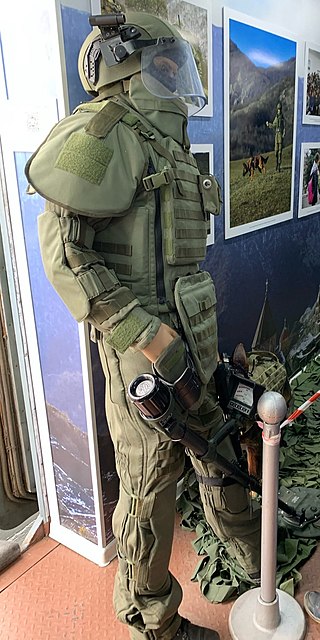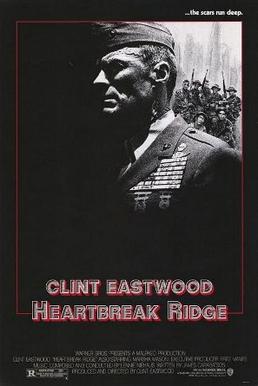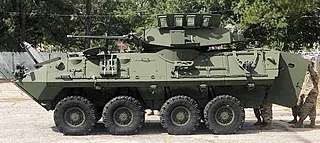Related Research Articles

A battalion is a military unit, typically consisting of up to one thousand soldiers commanded by a lieutenant colonel and subdivided into a number of companies, each typically commanded by a major or a captain. The typical battalion is built from three operational companies, one weapons company and one headquarters company. In some countries, battalions are exclusively infantry, while in others battalions are unit-level organisations.
A company is a military unit, typically consisting of 100–250 soldiers and usually commanded by a major or a captain. Most companies are formed of three to seven platoons, although the exact number may vary by country, unit type, and structure.

A regiment is a military unit. Its role and size varies markedly, depending on the country, service, or specialisation.

A sapper, also called a combat engineer, is a combatant or soldier who performs a variety of military engineering duties, such as breaching fortifications, demolitions, bridge-building, laying or clearing minefields, preparing field defenses, and road and airfield construction and repair.

A long-range reconnaissance patrol, or LRRP, is a small, well-armed reconnaissance team that patrols deep in enemy-held territory.

The 11th Armored Cavalry Regiment is a unit of the United States Army garrisoned at the Fort Irwin National Training Center in California. The regiment has served in the Philippine–American War, the Pancho Villa Expedition, World War II, the Vietnam War, Gulf War and Iraq War. The 11th ACR serves as the opposing force (OPFOR) for the Army and Marine task forces, and foreign military forces that train at Fort Irwin.

Operation Starlite was the first major offensive action conducted by a purely U.S. military unit during the Vietnam War from 18 to 24 August 1965. The operation was launched based on intelligence provided by Major general Nguyen Chanh Thi, the Army of the Republic of Vietnam (ARVN) I Corps commander. III Marine Amphibious Force commander Lieutenant General Lewis W. Walt devised a plan to launch a pre-emptive strike against the Viet Cong (VC) 1st Regiment to nullify their threat to the vital Chu Lai Air Base and Base Area and ensure its powerful communication tower remained intact.

The Amphibious Vehicle, Tracked (LVT) is an amphibious warfare vehicle and amphibious landing craft, introduced by the United States Navy and United States Marine Corps. The United States Army, Canadian Army and British Army used several LVT models during World War II, and referred to those vehicles as "Landing Vehicle, Tracked."

Heartbreak Ridge is a 1986 American military action comedy film produced and directed by Clint Eastwood, who also starred in the film. The film also co-stars Marsha Mason, Everett McGill, and Mario Van Peebles, and was released in the United States on December 5, 1986. The story centers on a U.S. Marine nearing retirement who gets a platoon of undisciplined Marines into shape and leads them during the American invasion of Grenada in 1983.

The M42 40 mm Self-Propelled Anti-Aircraft Gun, or "Duster," is an American armored light air-defense gun built for the United States Army from 1952 until December 1960, in service until 1988. Production of this vehicle was performed by the tank division of the General Motors Corporation. It used components from the M41 light tank and was constructed of all-welded steel.

The United States Army Quartermaster Corps, formerly the Quartermaster Department, is a sustainment and former combat service support (CSS) branch of the United States Army. It is also one of three U.S. Army logistics branches, the others being the Transportation Corps and the Ordnance Corps.

The LAV-25 is a member of the LAV II family. It is an eight-wheeled amphibious armored reconnaissance vehicle built by General Dynamics Land Systems and used by the United States Marine Corps and the United States Army.

The M35 2½-ton cargo truck is a long-lived 2½-ton 6×6 cargo truck initially used by the United States Army and subsequently utilized by many nations around the world. Over time it evolved into a family of specialized vehicles. It inherited the nickname "Deuce and a Half" from an older 2½-ton truck, the World War II GMC CCKW.
82nd Field Artillery Regiment is a field artillery regiment of the United States Army. The regiment has been involved in American conflicts dating back to the Mexican Civil War, as well as modern operations such as the War on Terrorism. There are two active and three inactive battalions in the regiment. Traditionally, the regiment has been aligned with the 1st Cavalry Division at Fort Cavazos, Texas and Fort Bliss, Texas.

The 75mm Pack Howitzer M1 was a pack howitzer artillery piece used by the United States. Designed to be moved across difficult terrain, gun and carriage could be broken down into several pieces to be carried by pack animals.

This article incorporates public domain material from websites or documents of the United States Army.

The Army Map Service (AMS) was the military cartographic agency of the United States Department of Defense from 1941 to 1968, subordinated to the United States Army Corps of Engineers. On September 1, 1968, the AMS was redesignated the U.S. Army Topographic Command (USATC) and continued as an independent organization until January 1, 1972, when it was merged into the new Defense Mapping Agency (DMA) and redesignated as the DMA Topographic Center (DMATC). On October 1, 1996, DMA was folded into the National Imagery and Mapping Agency (NIMA), which was redesignated as the National Geospatial-Intelligence Agency (NGA) in 2003.
A Combat Sustainment Support Battalion (CSSB) is a combat service support battalion of the United States Army. A CSSB can be attached to a sustainment brigade to support the brigade combat teams and support brigades assigned to a corps with maintenance, transportation, supply, field services, and distribution functions. The CSSB is task-organized with the subordinate units necessary to carry out its mission.
References
- 1 2 W. D. Burrows, Prakash M. Temkar, COL(Ret) K. K. Phull, MAJ T. C. Timmes, and T. E. Richards: "Force Health Protection and Military Drinking Water Supplies" in U.S. Army Medical Department Journal, January–March 2004, pp. 55-59, retrievable online at https://apps.dtic.mil/sti/pdfs/ADA491300.pdf (2024).
- 1 2 "US Army TM 5-4610-218-34 Water Purification Unit, Van Type Body Mounted, Electric Motor Driven". 1979. (A public document which includes the images that were deleted.)
- ↑ Oscar E. 'Ed' Gilbert with Duncan Anderson, consulting editor, 2006, The U.S. Marine Corps in the Vietnam War, III Marine Amphibious Force 1965-75, Osprey Publishing Ltd., p. 36
- ↑ ARMY CONCEPT TEAM IN VIETNAM (December 6, 1967). WATER SUPPLY IN THE REPUBLIC OF VIETNAM (PDF) (Report). U.S. Defense Technical Information Center. pp. A-30, A-34.
- ↑ Don C. Lindsten: "Technology transfer: Water purification, U.S. Army to the civilian community." The Journal of Technology Transfer, Vol. 9, No. 1 (September 1984), pp. 57-59